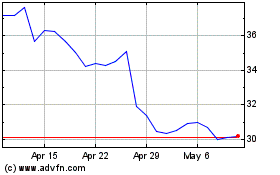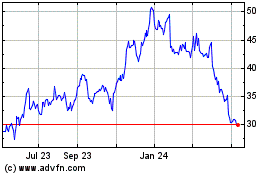By Alexandra Bruell
Last July, Intel Corp. set out to film polar bears in the Arctic
with a chartered ship and a skeleton crew of around 13 people,
including internal creative directors, producers and drone
specialists.
The crew, on a mission to make a video promoting the role of
Intel's drone technology in climate research, dealt with stormy
seas and a dwindling food supply -- the team chipped away at a
smoked reindeer leg and noshed on Ritz crackers and lettuce when
the four-day trip turned into a six-day one, an Intel spokeswoman
says. But they finally got their shot when a drone detected and
filmed a polar bear in its native habitat. A cameraman and sound
editor edited the footage on the ship, and months later the "Above
the Arctic" video appeared on YouTube, Facebook, Twitter and
Instagram.
The video, produced without help from an outside ad agency, is
now up for a couple of awards at the Cannes Lions International
Festival of Creativity. It also reflects a growing trend: More big
companies are hiring their own creative teams to write, produce and
place at least some of their advertising content, rather than
relying solely on an outside agency to do it for them.
While Intel still works with traditional ad agencies on a number
of projects, the stories around its technology are often better
served by the company's internal creative team, says Teresa Herd,
global creative director of Intel's central marketing function.
"An agency wouldn't be able to be OK with a skeleton crew like
that," she says, explaining that the Intel employees on the Arctic
voyage understood drone technology and were able to multitask. "My
guys were creating the piece, but also helping the drone guys fly
the drone."
More nimble
The shift to more in-house advertising work is apparent at
Cannes, which is often described as the Oscars of the advertising
industry. Last year, there was a 65% increase in the number of
entries created by brands, says Phil Thomas, chief executive
officer of the festival, adding that this year such entries are up
by more than 80%.
While the number is still small -- entries from brands accounted
for just 1,500 of 40,000 Cannes entries last year -- the increase
in submissions points to the shift in how some big companies are
approaching their marketing and advertising. Rather than
outsourcing all of their ad work to storied ad agencies, some of
the world's largest firms, including Procter & Gamble Co.,
Unilever PLC and J.P. Morgan Chase & Co., are investing in
their own creative teams as they build out digital marketing and
e-commerce strategies.
Advertisers say they are looking to move faster and spend less
on producing ads, as they jostle to get in front of consumers who
are spending more time online. A centralized, dedicated creative
team can eliminate the potential for duplicate roles across agency
partners -- a social-media manager working for the same brand at
both a creative and digital agency, for example. It also can reduce
the rounds of approvals needed to move forward with a project and
eliminate the need to share sensitive data with outside parties,
industry executives say.
Shortly after Chief Marketing Officer Whit Alexander joined Best
Buy Co. Inc. in 2015, the electronics retailer ended its
agency-of-record relationship with Crispin Porter + Bogusky and
began investing in more of its own marketing capabilities, hiring
designers, writers and production talent. More recently, Best Buy
has invested in analytics talent as it seeks to create more
targeted and effective ads, and plans to hire dozens of marketing
folks across creative and media, Mr. Alexander says.
The goal is cost-efficiency and a fresh creative approach, he
says.
"In the Mad Men days, there was one option for creative talent.
That was, join an agency," Mr. Alexander says. What he's seeing
now, "whether it's a generational thing or technology is enabling
it," is top creative talent opting to do freelance gigs or seeking
nonagency work, he says.
That doesn't mean that Best Buy is planning to move all of its
marketing in-house. A team from ad agency Wunderman currently
resides in Best Buy's office, he says, and works with the company's
in-house group.
Ms. Herd says that when she joined Intel in 2014, in-house
advertising work represented only about 5% of the total, with the
rest handled by an external ad agency. Now, the in-house work is
more like 60% of the total. When Intel initially started building
its internal agency, the cost savings were "profound," she says.
Employees still add costs, she says, just not as much as agency
talent.
Quality work?
Still, most companies say ad agencies will continue to serve an
important role -- especially on high-profile campaigns. Intel's
Super Bowl and Olympic ad campaigns, for example, were created in
partnership with agencies and are also up for awards at Cannes.
There are pitfalls associated with moving all advertising
in-house, industry and agency executives say. It is tough to hire
and retain young creative talent, especially in more remote
locations, where many large corporations are based, as well as keep
people happy working on only one brand. People who create
advertising like variety, they say, and working on only one account
can be stifling.
Much of what clients want to bring in-house is the cheap,
digital production work to create different versions of online ads
for different audiences, says Casey Burnett, founder of advertising
consulting firm Burnett Collective. Creative staffers "want to work
on big campaigns," he says. "The challenges are still the same. How
do you attract great talent; how do you keep that good talent; and
how do you keep it fresh and interesting?"
At the Cannes ad festival, the percentage of entries that win
Lions consistently has been around 3%, but the likelihood of an
in-house team winning a Lion is half that, says Mr. Thomas. (Intel
has won a Lion previously for in-house work.) "What that tells us
at the moment is, yes, they're producing more work and entering
more work into the festival, but is that work necessarily at the
standard of winning Lions? Data tells you it currently isn't."
Ms. Bruell is a reporter for The Wall Street Journal in New
York. Email alexandra.bruell@wsj.com.
(END) Dow Jones Newswires
June 18, 2018 13:22 ET (17:22 GMT)
Copyright (c) 2018 Dow Jones & Company, Inc.
Intel (NASDAQ:INTC)
Historical Stock Chart
From Mar 2024 to Apr 2024

Intel (NASDAQ:INTC)
Historical Stock Chart
From Apr 2023 to Apr 2024
